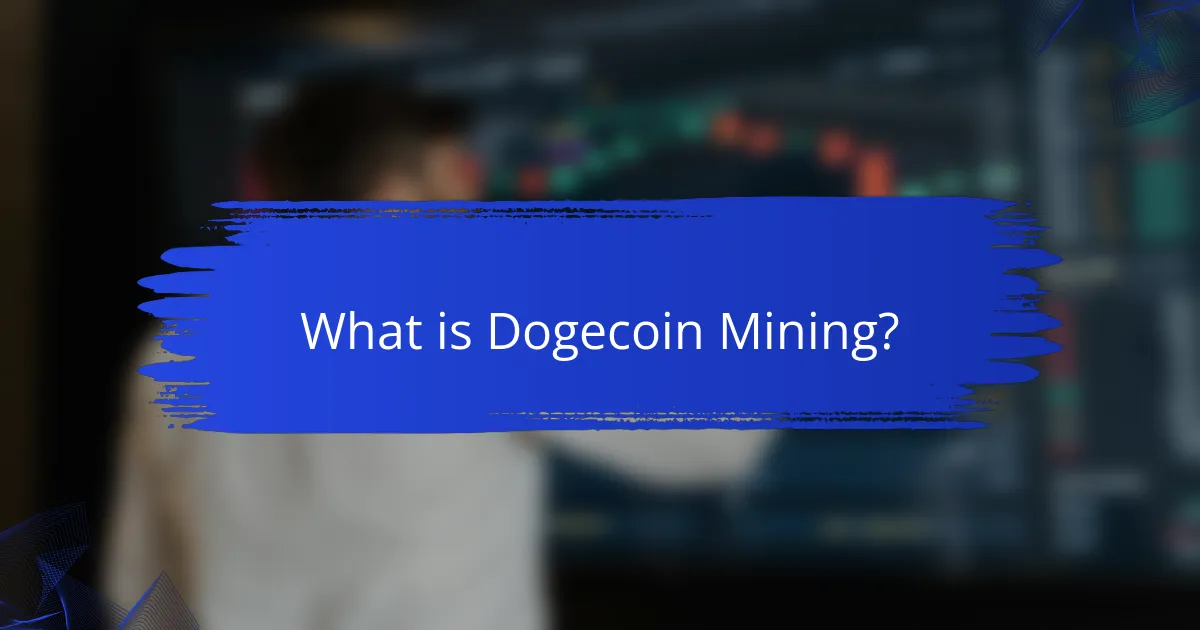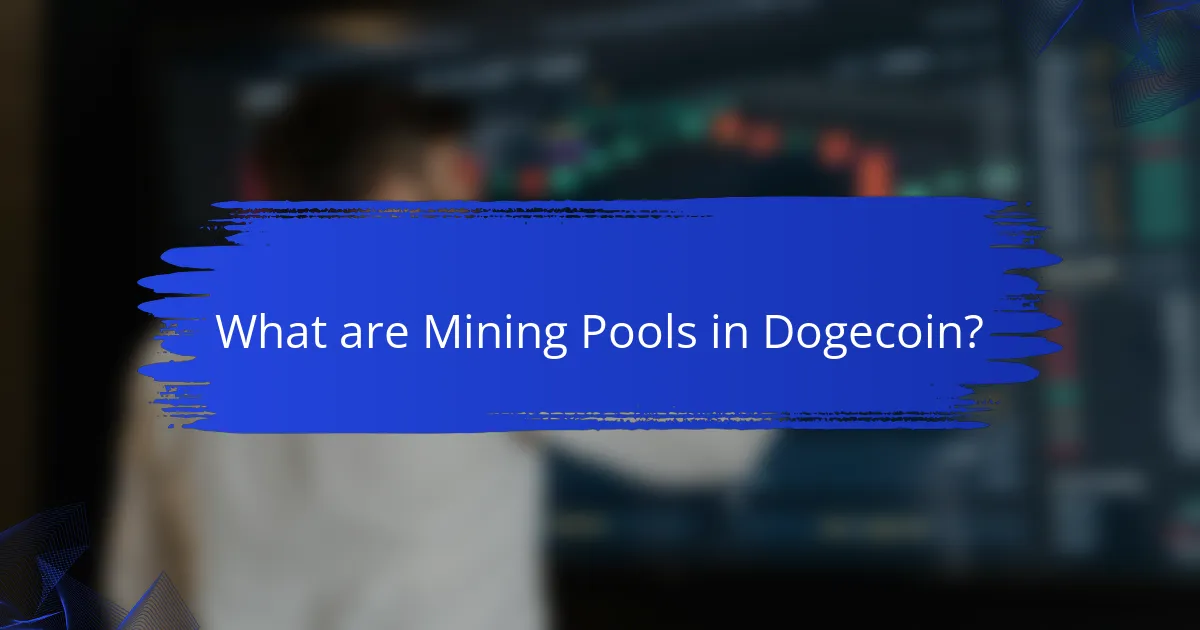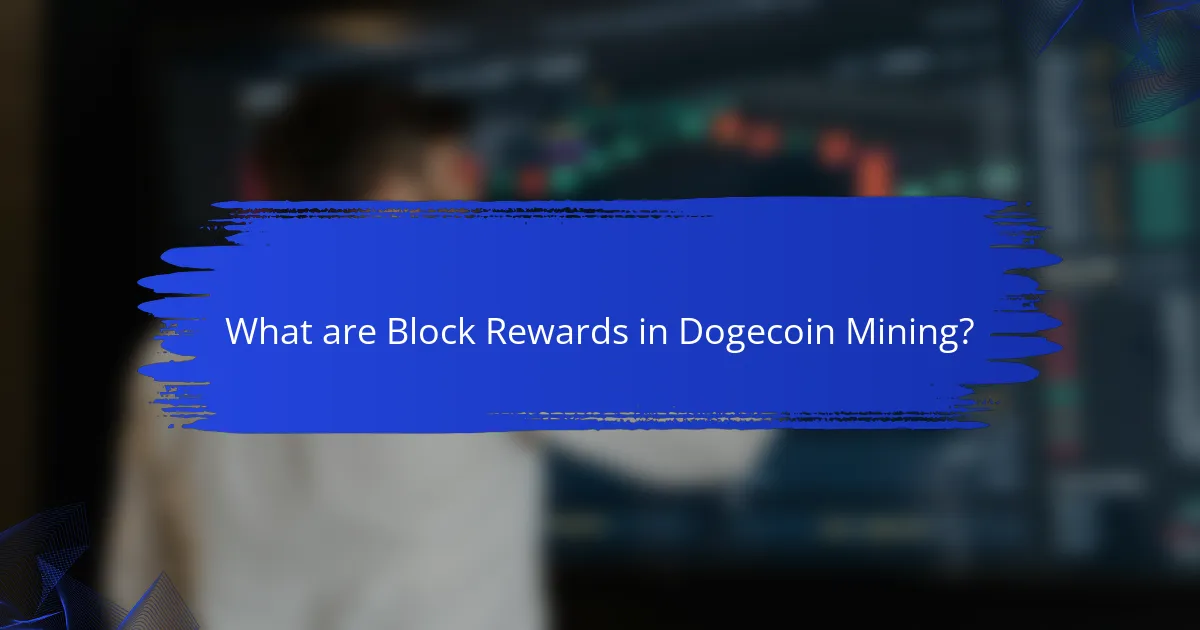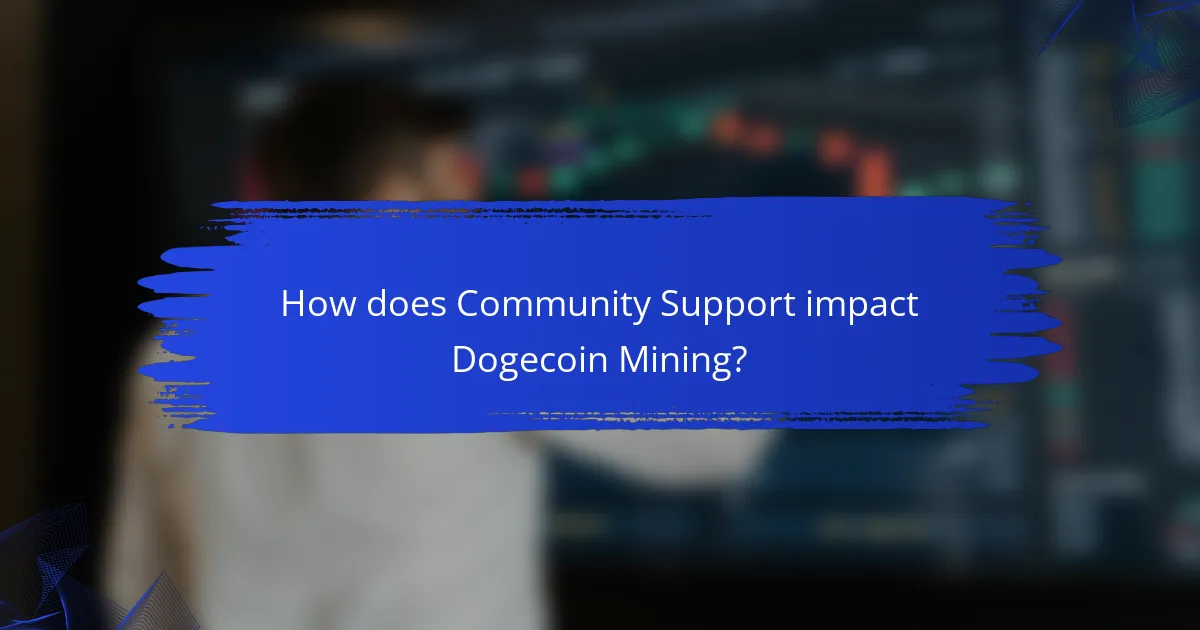Dogecoin mining involves validating transactions on the Dogecoin blockchain through a proof-of-work consensus mechanism, where miners solve complex mathematical problems to add new blocks and earn Dogecoin rewards. Currently, the block reward stands at 10,000 DOGE per block, contributing to the network’s security and the cryptocurrency’s supply control. Mining pools are collaborative groups that enhance the mining process by combining computational resources, allowing participants to earn more consistent rewards. Community support plays a vital role in Dogecoin mining by promoting collaboration, sharing best practices, and improving mining efficiency through shared knowledge and resources. This article will explore these key aspects of Dogecoin mining, including mining pools, block rewards, and the impact of community involvement.

What is Dogecoin Mining?
Dogecoin mining is the process of validating transactions on the Dogecoin blockchain. Miners use computational power to solve complex mathematical problems. Successful miners add new blocks to the blockchain and receive Dogecoin as a reward. The mining process helps secure the network and ensures transaction integrity. Dogecoin operates on a proof-of-work consensus mechanism. This means that miners compete to solve problems and confirm transactions. As of 2023, the block reward for mining Dogecoin is 10,000 DOGE per block. Mining also contributes to the overall supply and distribution of Dogecoin in the market.
How does the Dogecoin mining process work?
Dogecoin mining involves validating transactions on the Dogecoin blockchain. Miners use computer hardware to solve complex mathematical problems. Successful miners add new blocks to the blockchain. They receive Dogecoin rewards for their efforts. The mining process utilizes a proof-of-work mechanism. This mechanism requires significant computational power. Dogecoin’s mining algorithm is Scrypt, which is less resource-intensive than Bitcoin’s SHA-256. Miners can join mining pools to combine their resources. This increases the chances of earning consistent rewards.
What are the key components of Dogecoin mining?
The key components of Dogecoin mining include mining hardware, mining software, and a mining pool. Mining hardware consists of ASIC miners optimized for Dogecoin’s Scrypt algorithm. Mining software connects the hardware to the Dogecoin network and facilitates the mining process. A mining pool allows miners to combine their resources to increase the chances of earning rewards. Each component plays a crucial role in the efficiency and profitability of mining operations. These components work together to ensure that miners can successfully validate transactions and earn Dogecoin rewards.
How do miners validate transactions in Dogecoin?
Miners validate transactions in Dogecoin through a process called Proof of Work. This involves solving complex mathematical problems to confirm transaction legitimacy. Once a miner solves the problem, they broadcast the solution to the network. Other miners verify the solution before adding the block to the blockchain. Successful validation allows the miner to receive block rewards in Dogecoin. This process secures the network against fraud and double-spending. Dogecoin uses the Scrypt algorithm, which is less resource-intensive than Bitcoin’s SHA-256. This encourages more miners to participate in the network.
What are the benefits of Dogecoin mining?
Dogecoin mining provides several benefits. It allows users to earn Dogecoin as a reward for validating transactions. This process contributes to the security and integrity of the Dogecoin network. Miners help to maintain the decentralized nature of the cryptocurrency. Additionally, mining can be a profitable venture, especially during price surges. The community aspect of Dogecoin encourages collaboration among miners. This fosters a supportive environment for newcomers. Overall, Dogecoin mining enhances both individual and network value.
How does Dogecoin mining contribute to the network’s security?
Dogecoin mining contributes to the network’s security by validating transactions and preventing double-spending. Miners use computational power to solve complex mathematical problems. This process secures the blockchain by ensuring that only legitimate transactions are added. Each solved problem results in a new block being added to the chain. The more miners participating, the more secure the network becomes. A higher hash rate makes it difficult for malicious actors to manipulate the blockchain. According to data from blockchain explorers, Dogecoin’s hash rate has increased significantly over time. This increase in hash rate correlates with enhanced security for the network.
What financial incentives do miners receive from Dogecoin mining?
Miners receive financial incentives through block rewards and transaction fees when mining Dogecoin. Each time a miner successfully adds a block to the Dogecoin blockchain, they earn a block reward. As of October 2023, the block reward for Dogecoin is 10,000 DOGE per block. Additionally, miners can collect transaction fees from users who send Dogecoin. These fees vary based on network congestion and transaction size. The combination of block rewards and transaction fees provides a direct financial benefit to miners participating in the Dogecoin network.

What are Mining Pools in Dogecoin?
Mining pools in Dogecoin are collaborative groups where miners combine their computational resources. This collaboration increases the chances of successfully mining blocks. When a block is mined, the rewards are distributed among the participants based on their contributed power. Mining pools help individual miners earn more consistent rewards. They mitigate the variance in payouts that solo mining can experience. The larger the pool, the more stable the income for its members. Mining pools are essential for efficient Dogecoin mining. They enhance the overall mining process by pooling resources and sharing rewards fairly.
How do mining pools operate in the Dogecoin network?
Mining pools in the Dogecoin network allow multiple miners to combine their computational power. This collaboration increases the chances of successfully mining a block. When a block is mined, the rewards are distributed among the participants based on their contributed power. Dogecoin uses a Scrypt-based algorithm, which is memory-intensive and favors GPU mining. Mining pools help reduce the variance in payouts for individual miners. They provide a steady income stream by pooling resources together. Pool operators typically charge a small fee for their services. This structure enhances efficiency and encourages participation in the Dogecoin network.
What advantages do mining pools offer to individual miners?
Mining pools provide individual miners with increased chances of earning rewards. By combining their computational power, miners can solve blocks more efficiently. This collective effort leads to more frequent payouts compared to solo mining. In a mining pool, rewards are distributed among participants based on their contribution. This system minimizes the variance in earnings. Individual miners benefit from a steady income, even if smaller. Mining pools also offer access to shared resources and expertise. This collaboration enhances overall mining efficiency and competitiveness.
How do miners share rewards in a mining pool?
Miners share rewards in a mining pool based on their contributed computational power. This method is known as “proportional distribution.” Each miner’s share of the reward correlates to the amount of work they contributed. For instance, if a miner contributes 10% of the total computational power, they receive 10% of the rewards.
Many mining pools use a “pay-per-share” (PPS) system. In this system, miners earn a fixed amount for each share they submit, regardless of whether the pool finds a block. This provides consistent payouts. Other pools may use a “pay-per-last-N-shares” (PPLNS) model. In PPLNS, rewards are distributed based on the number of shares submitted over a certain timeframe.
The total reward is divided among miners after a block is successfully mined. This incentivizes collective effort while allowing individual miners to benefit from pooled resources.
What factors should miners consider when choosing a mining pool?
Miners should consider several factors when choosing a mining pool. These factors include the pool’s fees, payout structure, and reputation. Fees can vary significantly between pools. Lower fees can increase overall profitability. Payout structures, such as Pay Per Share (PPS) or Pay Per Last N Shares (PPLNS), affect how and when miners receive rewards. A reliable reputation ensures timely payments and transparency. Additionally, the pool’s hash rate impacts the likelihood of earning rewards. Miners should also consider the pool’s geographical location for latency issues. Lastly, community support can enhance the mining experience. These considerations help miners maximize their returns and ensure a positive mining experience.
How do pool fees impact miners’ earnings?
Pool fees reduce miners’ earnings by taking a percentage of the total rewards earned. Typically, these fees range from 1% to 3% of the block reward. For example, if a mining pool earns a reward of 10 Dogecoins and charges a 2% fee, miners receive 9.8 Dogecoins. This deduction can significantly impact a miner’s overall profitability, especially when mining in pools with higher fees. Miners must consider these fees when selecting a mining pool to maximize their earnings. Lower fees can lead to higher net rewards for miners.
What is the importance of pool size and hash rate?
Pool size and hash rate are critical factors in mining efficiency. A larger pool size increases the chances of finding blocks. This leads to more frequent rewards for miners involved. Hash rate measures the computational power of the mining pool. Higher hash rates enhance the likelihood of successfully mining blocks. For example, a pool with a hash rate of 1 TH/s has a better chance of solving cryptographic puzzles than one with 100 GH/s. Therefore, both pool size and hash rate directly impact the profitability and stability of mining efforts.

What are Block Rewards in Dogecoin Mining?
Block rewards in Dogecoin mining are the incentives given to miners for successfully adding a new block to the Dogecoin blockchain. When a miner solves a cryptographic puzzle, they validate transactions and create a new block. As a reward for their efforts, the miner receives a specific number of Dogecoins. Currently, the block reward is set at 10,000 Dogecoins per block. This reward structure helps secure the network and encourages miners to participate. The block reward is halved approximately every four years, similar to Bitcoin. This mechanism ensures a controlled supply of Dogecoin over time.
How are block rewards determined in the Dogecoin network?
Block rewards in the Dogecoin network are determined by a fixed amount per block mined. Each block mined rewards the miner with 10,000 Dogecoins. This reward structure is consistent and does not change over time. Dogecoin employs a proof-of-work consensus mechanism. Miners compete to solve cryptographic puzzles to validate transactions. The first miner to solve the puzzle adds the block to the blockchain. This process ensures the security and integrity of the network. The Dogecoin network has a block time of approximately one minute. This rapid block generation contributes to the stability of its reward system.
What is the current block reward for Dogecoin miners?
The current block reward for Dogecoin miners is 10,000 DOGE per block. This reward has remained unchanged since Dogecoin’s launch in December 2013. Dogecoin employs a proof-of-work consensus mechanism. Miners validate transactions and secure the network through this process. The block reward incentivizes miners to participate in the network. As of now, there are no plans to alter this reward. This consistency supports Dogecoin’s inflationary supply model. The total supply of Dogecoin is uncapped, allowing for continuous mining.
How does the block reward system affect mining profitability?
The block reward system directly impacts mining profitability by determining the amount of cryptocurrency miners receive for validating transactions. Higher block rewards increase the potential earnings for miners, making mining more profitable. Conversely, if block rewards decrease, miners earn less, which may reduce profitability.
For example, Dogecoin’s block reward is currently set at 10,000 DOGE per block. This consistent reward incentivizes miners to continue participating in the network. Additionally, as more miners join, the competition increases, potentially leading to diminishing returns for individual miners.
Overall, the block reward system is a crucial factor in the financial viability of mining operations. It shapes the incentives for miners and influences their decisions to invest in mining hardware and energy costs.
What happens to block rewards over time?
Block rewards decrease over time in a cryptocurrency network. This reduction often occurs through mechanisms like halving events. For example, Bitcoin experiences halving approximately every four years, cutting the block reward in half. In Dogecoin, block rewards are fixed but can be affected by network changes. The initial reward for Dogecoin was 1,000 DOGE per block. This reward decreases in terms of value as more coins are mined. Historical data shows that as the total supply increases, the value per block reward may diminish. This dynamic impacts miners’ incentives and network security.
How does Dogecoin’s inflation rate influence block rewards?
Dogecoin’s inflation rate directly impacts block rewards by determining the number of new coins generated over time. The inflation rate is set at approximately 5 billion Dogecoins per year. This consistent issuance of coins ensures that block rewards remain stable and predictable for miners. Each block mined rewards miners with 10,000 Dogecoins. The inflation rate influences the overall supply of Dogecoin, which can affect its market value. A higher inflation rate might lead to a decrease in value if demand does not keep pace. Conversely, a lower inflation rate could enhance value by limiting supply. Therefore, the inflation rate plays a crucial role in shaping the economics of Dogecoin mining and rewards.
What is the significance of block reward halving events?
Block reward halving events are significant as they reduce the number of new coins generated and distributed to miners. This occurs approximately every four years in many cryptocurrencies, including Bitcoin. The halving impacts the supply of new coins, creating scarcity. As the reward decreases, it can lead to increased demand and potentially higher prices. Historically, Bitcoin’s price has surged following halving events, indicating market reactions to reduced supply. For example, after the 2020 halving, Bitcoin’s price rose from around $8,500 to over $60,000 within a year. This trend highlights the importance of halving in influencing market dynamics and miner incentives.

How does Community Support impact Dogecoin Mining?
Community support significantly impacts Dogecoin mining by fostering collaboration and resource sharing among miners. A strong community encourages more participants to join mining pools. This increases the overall hash rate, enhancing the chances of successfully mining blocks. Additionally, community support leads to better dissemination of information about mining techniques and best practices. For instance, forums and social media groups provide platforms for miners to share experiences and strategies. This collective knowledge can improve efficiency and profitability in mining operations. Furthermore, community-driven initiatives can lead to funding for infrastructure improvements, such as better hardware or software tools. Overall, an engaged community contributes to a more robust and successful Dogecoin mining ecosystem.
What role does the Dogecoin community play in mining activities?
The Dogecoin community plays a significant role in mining activities by providing support and resources for miners. Community members often collaborate in mining pools to increase efficiency and share rewards. This collective effort helps new miners access resources and knowledge. The community also promotes awareness about mining best practices and encourages participation. Additionally, social media platforms and forums serve as valuable spaces for sharing updates and strategies. The active involvement of the community fosters a sense of belonging among miners. This engagement ultimately contributes to the stability and growth of the Dogecoin network.
How can miners engage with the Dogecoin community for support?
Miners can engage with the Dogecoin community for support through various channels. They can participate in online forums and social media groups dedicated to Dogecoin. Active involvement in these platforms allows miners to share experiences and seek advice. Joining mining pools can also provide a sense of community and collective support. Miners can attend Dogecoin-related events and meetups to connect with others in person. Contributing to community discussions and projects fosters relationships and builds trust. Engaging with Dogecoin developers can also provide insights and updates on network improvements. Overall, consistent participation in these activities strengthens ties within the Dogecoin community.
What resources are available for Dogecoin miners within the community?
Dogecoin miners have access to various resources within the community. These include online forums dedicated to Dogecoin discussions. Miners can find tutorials and guides on mining techniques. Additionally, there are social media groups where miners share tips and experiences. Mining pools specifically for Dogecoin are available, allowing miners to collaborate. Websites provide real-time statistics on mining performance and profitability. Resources also include wallets that support Dogecoin transactions. Furthermore, community events and meetups facilitate networking among miners. These resources enhance the mining experience and foster community support.
What are some best practices for successful Dogecoin mining?
Choose efficient mining hardware specifically designed for Dogecoin. ASIC miners are optimal due to their high hash rates. Join a reliable mining pool to increase chances of earning rewards consistently. Mining pools combine resources and share rewards among members. Maintain a stable internet connection to ensure uninterrupted mining operations. Monitor temperatures and ensure proper cooling to prevent hardware damage. Regularly update mining software to benefit from improvements and security fixes. Keep track of Dogecoin market trends to optimize mining strategies.
How can miners optimize their mining rigs for better performance?
Miners can optimize their mining rigs for better performance by upgrading hardware components. Enhanced graphics processing units (GPUs) can significantly increase hash rates. Miners should also ensure adequate cooling systems to prevent overheating. Proper power supply units (PSUs) are essential for stable performance. Overclocking GPUs can boost mining efficiency but requires careful monitoring. Additionally, miners should use optimized mining software tailored for Dogecoin. Regular maintenance and cleaning of hardware can prevent dust buildup, which affects performance. Monitoring power consumption can help in managing costs effectively. These strategies collectively contribute to maximizing mining rig performance.
What troubleshooting tips can help miners resolve common issues?
Miners can resolve common issues by following specific troubleshooting tips. First, ensure that mining hardware is properly connected and powered. Check all cables and connections for any damage or loose fittings. Next, verify that the mining software is correctly configured. Incorrect settings can lead to connection issues with mining pools.
Monitor the system temperature to prevent overheating. Excessive heat can cause hardware malfunctions. Additionally, regularly update mining software and firmware to benefit from improvements and bug fixes.
If miners experience low hash rates, they should check their internet connection stability. A weak connection can disrupt mining activities. Finally, consult community forums for advice on specific issues. Many miners share solutions to common problems, making these forums valuable resources.
Dogecoin mining is the process of validating transactions on the Dogecoin blockchain, where miners solve mathematical problems to add new blocks and earn rewards. This article covers the mining process, including the use of mining pools, the significance of block rewards, and the impact of community support on mining activities. Key components such as mining hardware, software, and the proof-of-work consensus mechanism are discussed, along with the benefits and financial incentives for miners. Additionally, best practices for optimizing mining performance and troubleshooting common issues are provided to enhance the overall mining experience.